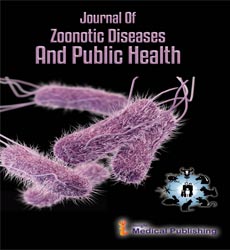Abstract
Seroprevalence and Spatial Analysis of Canine Visceral Leishmaniasis in the Pantanal Region, Mato Grosso State, Brazil
Introduction: Visceral Leishmaniasis (VL) is a zoonotic disease of public health importance, whose main reservoir is the domestic dog. The purpose of this study was to evaluate the prevalence and spatial distribution of Canine Visceral Leishmaniasis (CVL), as well as factors associated with the disease, in the municipality of Barão de Melgaço.
Methods: Serum samples from 402 dogs in urban and rural areas were subjected to an immunochromatographic rapid test (DPP, TR DPP® LVC–Bio-Manguinhos/FIOCRUZ) and the enzyme-linked immunosorbent assay (ELISA, EIE® LVC–Bio-Manguinhos/FIOCRUZ). An epidemiological questionnaire was used to identify factors associated for CVL using a logistic regression model. The presence of spatial autocorrelation was performed using global and local Moran’s indices.
Results: Seventeen dogs were reactive to both diagnostic tests, indicating a prevalence rate of 4.2% in the municipality, and a statistically significant association with hyperkeratosis and splenomegaly (P<0.05). Through the global Moran index, a density map was built for show the spatial distribution of CVL cases, showing a positive correlation among all the evaluated areas (I<0.25). Local Moran index was used to create a cluster map, identifying areas with high, low and intermediate priority for control of CVL.
Conclusions: The prevalence of CVL in Barão de Melgaço was of 4.2%, being characterized as area with moderate transmission and receptive to the occurrence of human cases. In this study, the use of spatial analysis stood out as a strategic tool in the control of CVL, enabling different action strategies to be applied in each region.
Author(s): Álvaro Felipe de Lima Ruy Dias, Arleana do Bom Parto Ferreira de Almeida, Felipe Augusto Costantino Seabra da Cruz, Rafael Rodrigues da Silva, Juliana Yuki Rodrigues, Amanda Atsumy Funakawa Otsubo, Anderson Castro Soares de Oliveira and Valéria Régia Franco Sousa*
Abstract | Full-Text | PDF
Share This Article
Google Scholar citation report
Citations : 59
Journal of Zoonotic Diseases and Public Health received 59 citations as per Google Scholar report
Abstracted/Indexed in
- Google Scholar
Open Access Journals
- Aquaculture & Veterinary Science
- Chemistry & Chemical Sciences
- Clinical Sciences
- Engineering
- General Science
- Genetics & Molecular Biology
- Health Care & Nursing
- Immunology & Microbiology
- Materials Science
- Mathematics & Physics
- Medical Sciences
- Neurology & Psychiatry
- Oncology & Cancer Science
- Pharmaceutical Sciences
